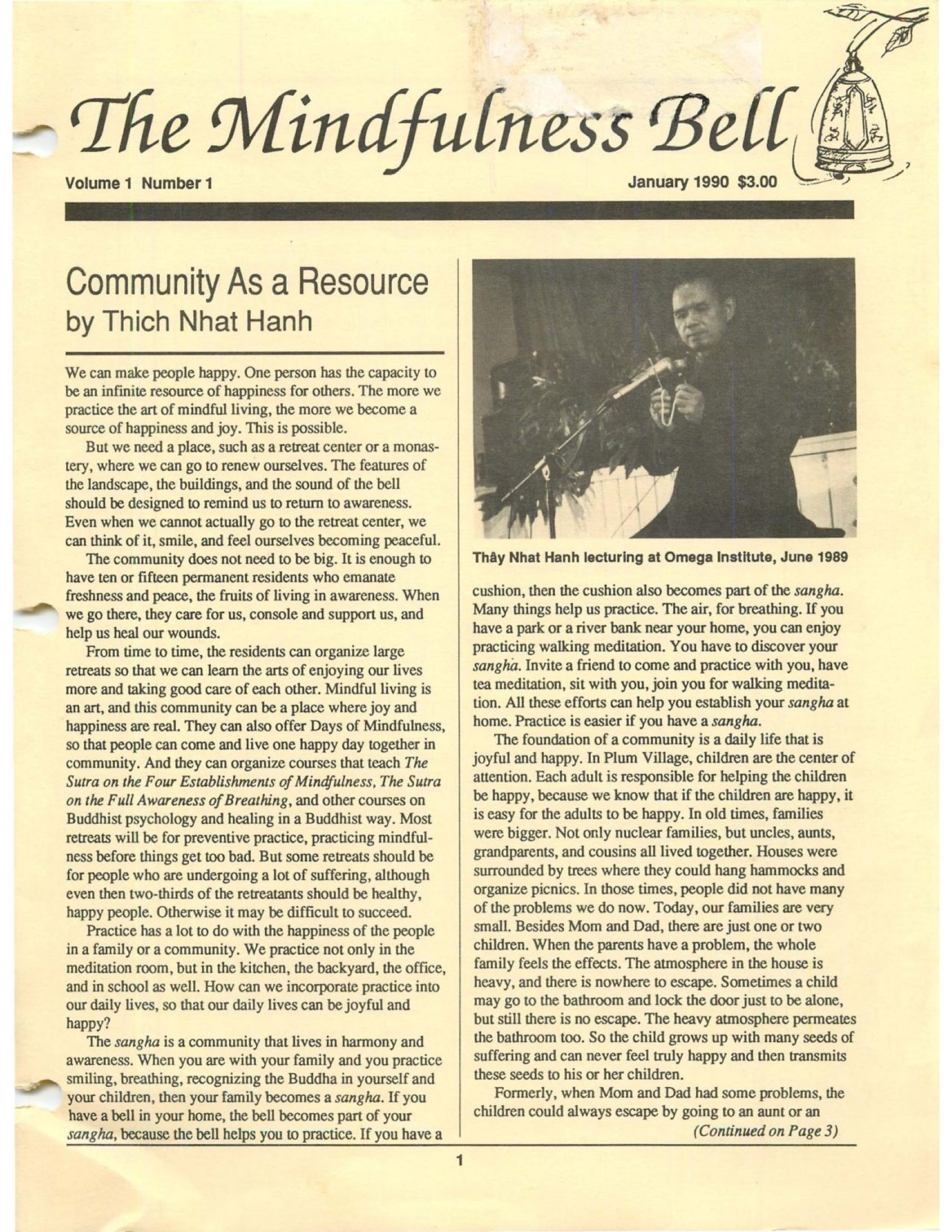
Inviting the Bell to Sound
Body, speech, and mind in perfect oneness.
I send my heart along with the sound of the bell.
May the hearers awaken from forgetfulness
and transcend all anxiety and sorrow.
In Buddhist meditation centers, we often use bowl-shaped bells to punctuate the day, calling the community to mindfulness. Standing or sitting in front of the bell,

Inviting the Bell to Sound
Body, speech, and mind in perfect oneness.
I send my heart along with the sound of the bell.
May the hearers awaken from forgetfulness
and transcend all anxiety and sorrow.
In Buddhist meditation centers, we often use bowl-shaped bells to punctuate the day, calling the community to mindfulness. Standing or sitting in front of the bell, we join our palms, breathe three times, and recite this verse. We hold the bell "inviter" (a wooden stick) in one hand and, if the bell is small, we hold it in the palm of the other. We concentrate on the position of our hand and the stick. First we "wake the bell up" by touching its rim lightly with the stick. This brief sound tells everyone that a full sound of the bell is coming in a moment.
During retreats, the sound of the bell reminds us to return to our breathing in the present moment. When we hear it, we stop talking and thinking, and breathe consciously three times. It is important that the person who invites the bell to sound quiets his own being first. If his body, speech, and mind are quiet and in harmony when he invites the bell, the sound will be solid, beautiful, and joyful, and this will help the hearers to wake up to the present moment and overcome all anxiety and sorrow.
Hearing the Bell
Listen, listen,
this wonderful sound brings me back to my true self.
Hearing the bell, we make our minds one with the sound of the bell, allowing our minds to vibrate along and settle down with the sound of the bell as it fades away. In this way the mind is collected and brought back into the present moment. The "Bell of Mindfulness" is the voice of the Buddha calling us back to ourselves. We have to respect such a sound, stop our thinking and talking, and get back in touch with ourselves, breathing and smiling. It is not a Buddha from the outside. It is our own Buddha calling us. If we cannot hear the sound of the bell, then we cannot hear other sounds which also come from the Buddha, like the sound of the wind, the sound of the bird, even the sounds of cars or the sound of a baby crying. They are calls from the Buddha, inviting us to return to ourselves. Practicing with a bell from time to time is helpful.
In our society there are many bells--church bells, school bells, grandfather clocks, even telephone bells. Once you can practice with a bell, you can practice with the wind and other sounds. After that you can practice not only with the sounds, but with forms, such as the sunlight coming through your window. "Silent bells" such as "Stop" signs, red lights, or the face of a child, can call us back to the present moment. These, too, are bells of mindfulness.
Excerpted from Present Moment, Wonderful Moment: Mindfulness Verses for Daily Living by Thich Nhat Hanh (Parallax Press. April 1990).
From the Editors
Many of the readers of The Mindfulness Bell are familiar with these verses which accompany the bell of mindfulness sounded during retreats with Thay. Practicing with the bell--sometimes several hundred of us--reinforces the sanity of stopping from time to time to return to ourselves. When we resume our activity, we are usually a little calmer, clearer, and more aware.
During the retreat in northern California last Spring, a number of us met to begin planning a newsletter which could serve as a communications link among the increasing number of people worldwide who practice mindfulness in sitting meditation and daily life. Carole Melkonian, Therese Fitzgerald, and Arnie Kotler agreed to be the core staff, and, at last, we present this first issue. We hope this collection of writings, verses, drawings, and photographs will "ring true" as reminders of what helps cultivate joy and understanding in our lives. The theme for this issue is community, or sangha.
There are four kinds of sangha. In traditional Buddhist circles, sangha means the monks and nuns who have taken the 200+ vows of ordination. In contemporary, Western Buddhism, the term has been expanded to include all who practice mindfulness. At a retreat last year, poet Deena Metzger coined the term "interdenominational floating sangha" to refer to the community of all who are more-or-less on this path, even if we see each other only occasionally. There are also local sanghas, groups of women and men who meet daily, weekly, or monthly, for sitting, walking, tea meditation, precept recitation, and/or discussion. And there are residential communities who practice peacefully and joyfully together. Presently such communities exist in Montreal, Quebec; Sydney, Australia; and Meyrac, France. A small group of us, based in northern California, is in the process of looking for land to establish such a community in the United States.
We hope you enjoy this first effort at creating a Mindfulness Bell newsletter, and we hope you will help us improve it and make it what you need. We will continue as a quarterly (January, April, July, and October). Please send your articles and announcements to The Mindfulness Bell, c/o Parallax Press, P.O. Box 7355, Berkeley, CA 94707. Don't be shy. We really can help each other.
Therese Fitzgerald, Carole Melkonian, and Arnie Kotler.
Illustration by Michelle Benzamin Masuda.

